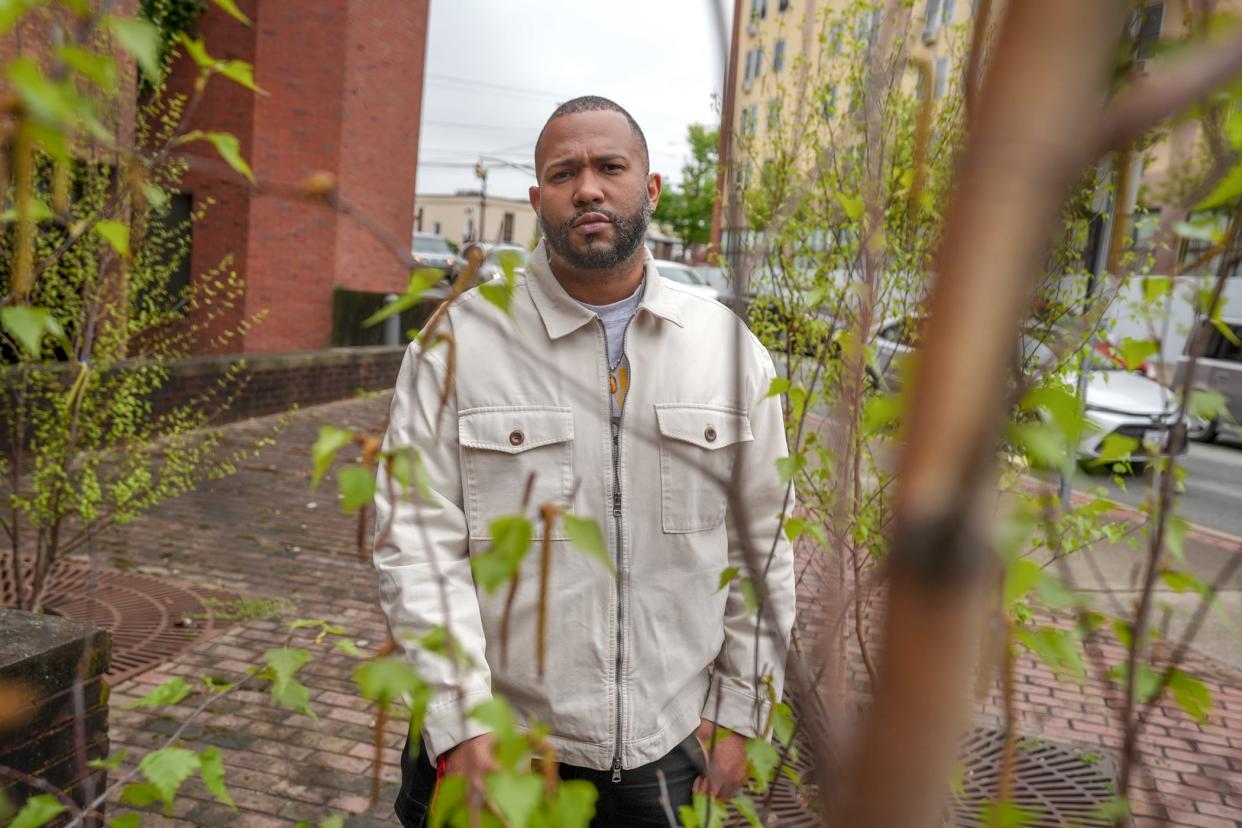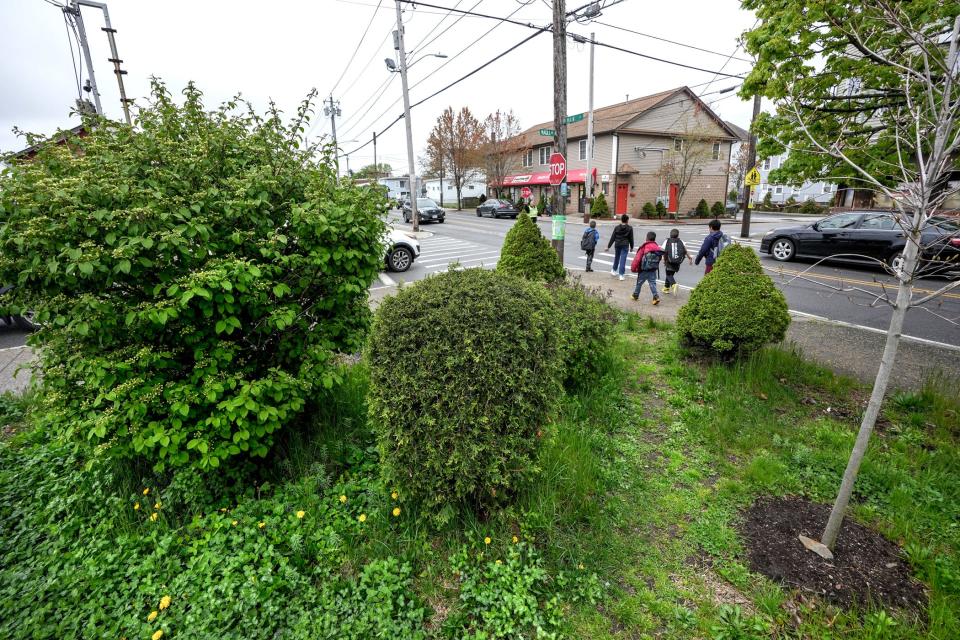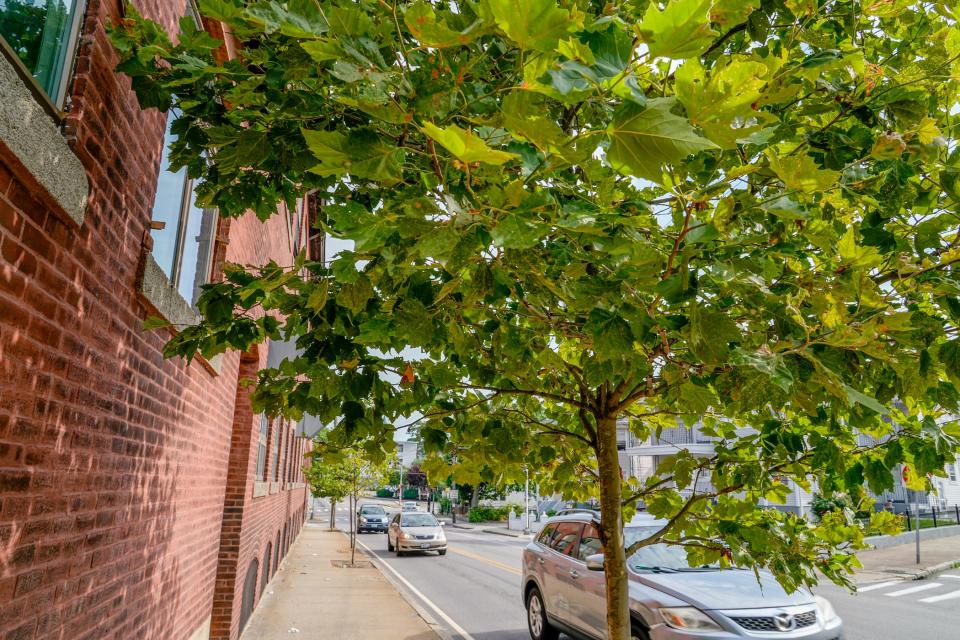He’s creating several football fields’ worth of shade in neighborhoods needing it the most

PAWTUCKET — Kufa Castro got his nickname as a teenager playing basketball on the courts at Prospect Heights Apartments, a New Deal-era public housing complex near the east bank of the Blackstone River.
His hard-nosed playing style reminded his teammates of a player with that first name in his native Dominican Republic. Castro’s given name Leandro melted away in the heat of competition. He was Kufa.
If you heard his name in the years afterward, it would probably have been for one of his Afro-Latino hip-hop albums. Or maybe you’d seen him in the Spanish-language production of Romeo and Juliet that toured the state, the one for which he also translated the script.
In the last few years Castro made another name for himself as the head of an innovative program called Trees4Us to plant gingkos, London planes and other hardy species of tree along urban streets plagued by summer heat within the former industrial corridor along the Blackstone River in Pawtucket, Rhode Island.
We found him this summer as USA TODAY Network journalists from more than 35 newsrooms worked on a project called "Perilous Course," about the human response to climate crisis along the East Coast. Our search for understanding included experts and scientists but also regular people who were making a difference.

Castro stood out as someone who'd accomplished a good deal but also had little in his background to specially prepare him for success at fighting the climate crisis. There are normal people in every community we cover along the East Coast who could do something at the same level of impact.
He knew about community building and equity issues when the nonprofit Groundwork Rhode Island tapped him for the position. But trees?
“Before this job, I’d never planted a tree,” he said, laughing.
The program has planted some 190 trees in Pawtucket and Central Falls, hard-on-their-luck mill towns known more for concrete-and-asphalt streetscapes than verdant greenways. The effort has become a model for adding trees in the places they’re needed most.
Places like downtown Pawtucket, where not a single tree can be seen on one busy stretch of Main Street lined with shops, restaurants and offices that cuts through the heart of the city.
Castro circles the block where the school department has its headquarters, pointing out what the program has done. There were no trees here before Trees4Us went to work. Now, plane tree saplings stand in a row alongside a blacktop parking lot. A trio of similarly sized gray birches has pride of place near the front entrance of an office building. None of the new trees offer much shade yet, but with some care they will in a future year.
Castro explained how expanding tree cover is more than a way of shielding neighborhoods from heat waves getting worse with climate change.
Their leaves filter air pollutants, which is especially important in a state that perennially ranks among the worst in the nation for asthma rates.
Their roots absorb rainwater that would otherwise run into rivers and streams, carrying oils and other contaminants all the way to Narragansett Bay.
And they enhance quality of life in places that don’t have the type of green spaces taken for granted in suburban America.
Castro, 35, grew up in neighborhoods not far from here. He speaks from experience about what trees can bring to low-income areas that disproportionately suffer environmental harm. “It grounds folks in a way that I feel like they’ll want to stay in the city,” he said. “There’s always this whole gloom over people, like they just want to get out. I really care about these places, and I want people to plant their roots here.”
Regaining a connection to the land
Castro spent his early childhood in Santo Domingo, the capital of the Dominican Republic. He was seven when his mother brought him and his brother to Rhode Island and she found work in a jewelry factory.
They lived in South Providence and spent time in Prospect Heights and other urban neighborhoods in Pawtucket before settling in the city’s Woodlawn section, an area of sprawling 19th-century red-brick factories surrounded by double- and triple-decker houses between Route 95 and the Blackstone.
When his mother wanted to take her boys outside to a park, they would drive to wealthy enclaves on the East Side of Providence, where mature oaks and maples proliferate.
“I see how it created issues of status,” Castro said. “Nobody in that neighborhood looked like us. We were just visiting.”
Through much of his twenties, Castro focused on his first love, the performing arts. He recorded a trio of hip-hop albums, made music videos, wrote poetry, and translated three Shakespeare plays for productions by Trinity Repertory Company and Rhode Island Latino Arts.
Castro supported himself by working at his uncle’s South Providence bodega, where he ran the deli counter.
One day, he went with a friend to pick up her produce from a farm-share program and was amazed by the overflowing baskets of colorful heirloom tomatoes. “That was my first time being introduced to locally grown food here in Rhode Island,” he said. “And I was 30.”
It felt revelatory. He thought about childhood visits to the Dominican countryside, how the people there lived off the land, and how he’d lost that connection after moving to America.
He signed up for courses in gardening and became an agricultural apprentice with Southside Community Land Trust in Providence.
A mile without seeing a tree
Castro started working four years ago for Groundwork Rhode Island, an organization devoted to improving the environment in disadvantaged neighborhoods.
It wasn’t such a stretch for him. He’d always thought of his contributions to the performing arts as a way of community organizing. And, with his newfound interest in all things green, getting a job with the environmental group seemed fortuitous.
One day, members of Groundwork’s summer youth group complained to Castro about playing basketball at a Pawtucket sports complex. There was just no place to get a break from the sun, they told him.
Talking to the teens under his charge, Castro recalled similar feelings about the absence of trees where he played at the Prospect Heights courts, that same inability to escape the heat. It also reminded him of what he saw leading cultural history walking tours through Providence and Central Falls for Rhode Island Latino Arts.
“We’d go a mile without seeing a tree,” he said.
A Rhode Island Department of Health study showed neighborhoods with few trees like Olneyville or Federal Hill — areas similar to those around the Pawtucket sports facilities or in Central Falls — can be up to 13 degrees hotter than Mount Pleasant or the streets around Blackstone Boulevard, where trees are plentiful.
Through a project called Climate Safe Neighborhoods, Castro and others at Groundwork started talking to residents of urban areas about how they were feeling the effects of climate change and what needed to be done to address the problems.
Again and again, residents said heat was their top concern — the No. 1 request — more trees.
Castro realized that trees aren’t just luxuries to adorn streets. Tree cover is essential urban infrastructure, a public health necessity in a state that is among the fastest warming in the nation.
Reaching out to the places that need trees the most
Finding areas that needed trees was easy with the help of an online mapping tool known as Tree Equity Score that was developed by the conservation group American Forests. The organization’s canopy maps take into account income, race and health factors and overlays them with the locations of urban heat islands. The group selected Rhode Island for a deeper dive that also projects impacts of planting scenarios on carbon capture, runoff and utility bills.
Signing up participants in marginalized neighborhoods of people often with less education, who aren’t as familiar with government services, or who don’t speak English was more difficult.
Standard English-language ads reached the wrong people.
On one phone call with a woman who called from leafy Oak Hill, Castro used Google Earth to find a satellite image of her property. He couldn’t even see her house because of the nearly unbroken tree canopy above it.
“But she said, ‘I’ve got room for one more,’” he recalled with a smile and shake of his head.

So he approached community groups like Progreso Latino for advice, talked to people he knew from his childhood, and enlisted neighborhood leaders to act as ambassadors in places with large populations of immigrants. Pawtucket has the second-largest Cape Verdean community in the country and sizable numbers of people from Guatemala and the Dominican Republic.
They soon found homes for trees on downtown sidewalks and around local schools. It took rounds of knocking on doors to enlist homeowners. In the end, the majority of trees went to residents, ideally in front yards where they can also shade sidewalks.
“Wherever anyone had space, basically we were able to plant,” Castro said.
Targeting the streets with low tree equity reveals roots of redlining
Castro and Amelia Rose, executive director of Groundwork Rhode Island, walk over to a nondescript triangle of grass sandwiched between a strip mall and Main Street in Pawtucket. A laundromat sits on one side, a car wash on another.
They point out a handful of slender trees that have been planted among the shrubs. Apart from some desultory looking street trees, they’re the only bit of green around this intersection in Woodlawn.
The tree equity score here is a dismal 47. Compare that to Oak Hill, with its score of 93, or Blackstone, where it’s 96. Trees4Us targeted streets with scores below 75.
“We looked at the maps, and we matched it with our lived experiences,” Castro said. “We know where the hottest places are.”
Groundwork traces the absence of trees in neighborhoods like this to “redlining,” the nearly century-old discriminatory practice of grading places for lending risk.
Typically, under the post-Depression federal program, neighborhoods deemed risky investments, those that were redlined, were poorer and had a greater share of people of color. Housing values consequently fell and publicly funded maintenance and improvements dropped off.
The effects are still being felt today. An analysis by Groundwork’s national parent organization of neighborhoods in Rhode Island, Virginia, New Jersey and Colorado found that those that were once redlined have less tree cover today, more impervious surface and experience higher average temperatures than those that received more favorable real estate lending grades.
“It’s not like it just happened overnight,” Rose said. “It’s a product of policy decisions from long, long ago that still reverberate now.”
Carmelo Frias, the owner of the strip mall with the lonely patch of plantings, had been asking the city for a while to plant trees along his stretch of Main Street, where he also owns a bodega. So when Castro, who he knows from the neighborhood, offered free saplings for his little plot, Frias didn’t think twice.
He worries about climate change and said the new trees will eventually provide needed shade in his corner of Woodlawn.
“It's good for the environment to have more trees around,” he said. “It beautifies the neighborhood.”
Frias moved to Rhode Island from the Dominican Republic when he was 18. Now 59 and a successful businessman, he’s aware of the disparities in tree cover and thinks there’s a reason for what he sees as foot-dragging by the city to plant more in his neighborhood.
“Maybe they don’t care as much,” Frias said. “It’s mostly migrants here.”
‘They’re naming their trees’
Castro admits to feeling angry and frustrated after he learned more about redlining and the environmental burdens in urban neighborhoods. He’s only half-joking when he described his visits to engage residents about climate change as his “doom tours.”
The work at Groundwork helped harness his emotions.
“Kufa was working with our youth program to do not just tree-planting, but building raised-bed gardens at people’s homes and installing rain barrels,” Rose said. “It’s little things that you may think don’t really matter, but to each individual person, it does matter.”
The program in Pawtucket and Central Falls is winding down. Groundwork is set to expand the effort into nearby communities — following the Blackstone north to Cumberland, Lincoln and Woonsocket to plant another 2,000 trees. The organization also has funding from the court settlement for a pollution case to plant 400 trees in South Providence.
Castro’s position was grant-funded and ended at the close of 2021. He’s now working at Building Futures, a construction apprenticeship program. He’s still involved in tree-planting, though.
As a member of a coalition steering committee, he is working with The Nature Conservancy, American Forests, city officials and other partners to apply some of the same principles from Trees4Us to Providence.
“We want these tree-planting programs to focus their resources,” he said. “There are neighborhoods that are screaming about how hot they are.”
The results of Trees4Us can be seen in the many little saplings around Pawtucket and Central Falls, identifiable as part of the program by yellow tags, weathered over time, that announce “NEW TREE IN TOWN.”
Castro still hears from people about how much they love the new additions to their yards.
“They’re naming their trees. They’re taking photos with them,” he said. “They’re just so happy.”
By the time the trees Castro planted reach their canopy maturity in a few decades, they will be creating several football fields' worth of shade.
There have been some bumps along the way.
Castro has found out that it’s going to take more cajoling to convince some people that trees are worth the effort. It’s been a challenge even with his own mother. She dug out a cherry tree he gave her because she was worried that its roots would damage her home’s water line.
Castro found the uprooted sapling lying in her yard, a little worse for wear. He put the tree in a pot and packed good soil around it. He’s been watering it and nursing it back to health.
Soon, with luck, it will be ready for him to plant somewhere else.
This article is part of a USA TODAY Network reporting project called "Perilous Course," a collaborative examination of how people up and down the East Coast are grappling with the climate crisis. Journalists from more than 35 newsrooms from New Hampshire to Florida are speaking with regular people about real-life impacts, digging into the science and investigating government response, or lack of it.
This article originally appeared on The Providence Journal: RI tree planting program helping to bring relief to hottest areas

